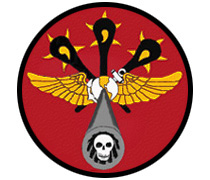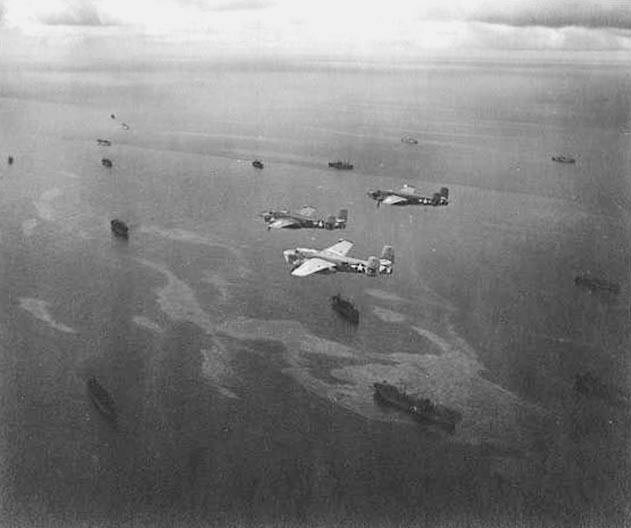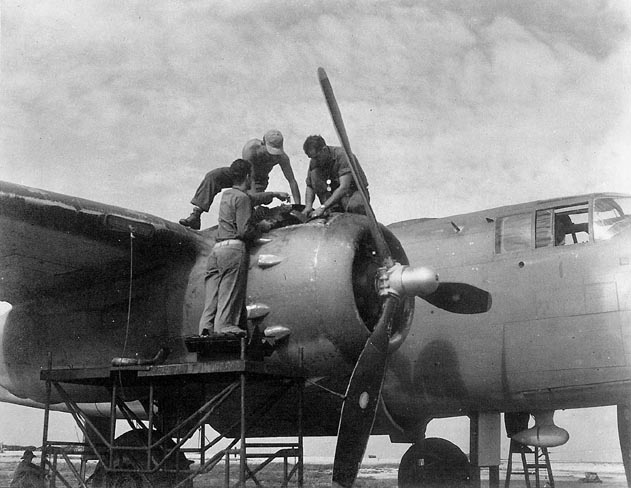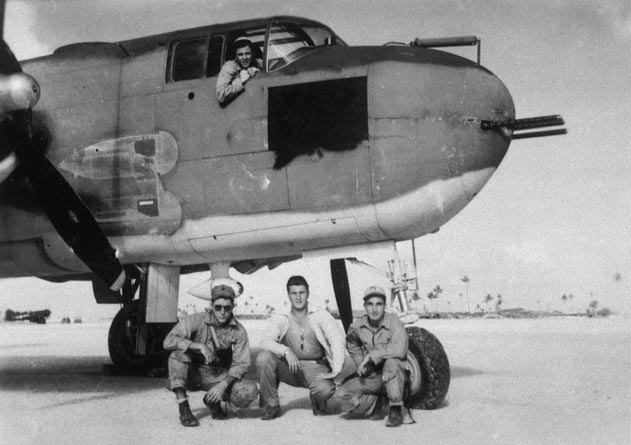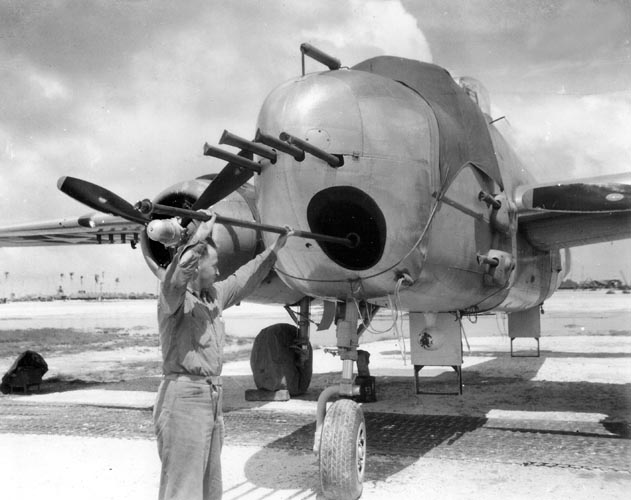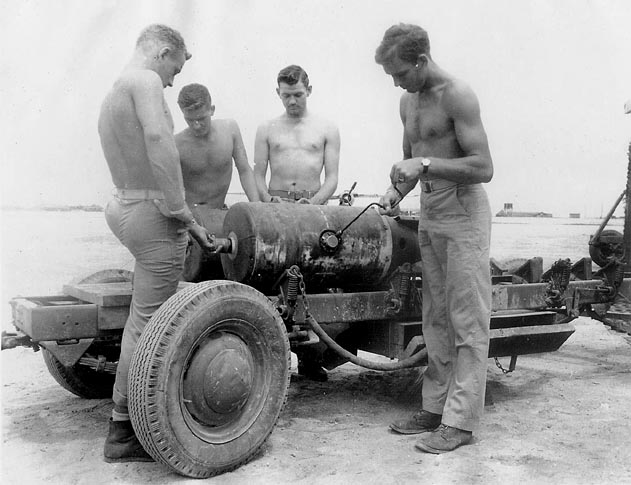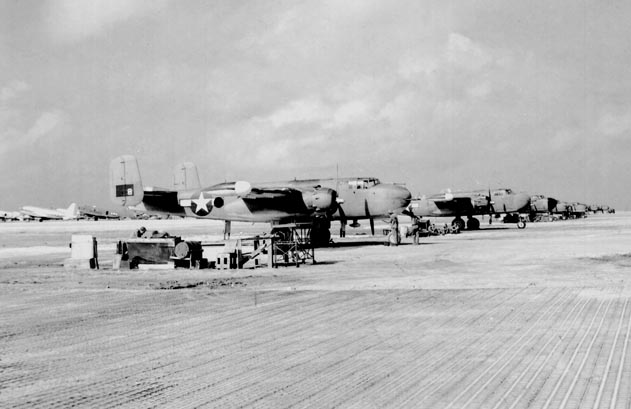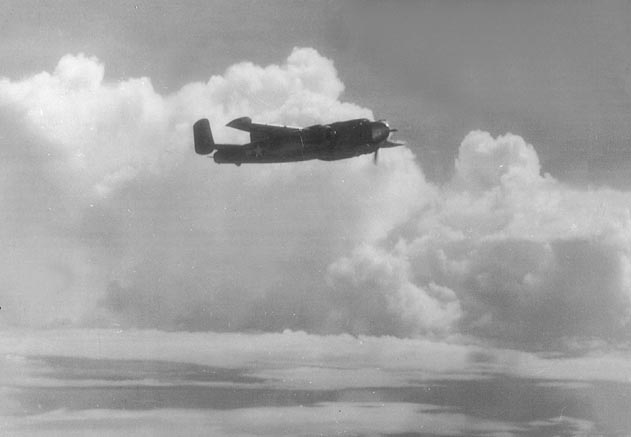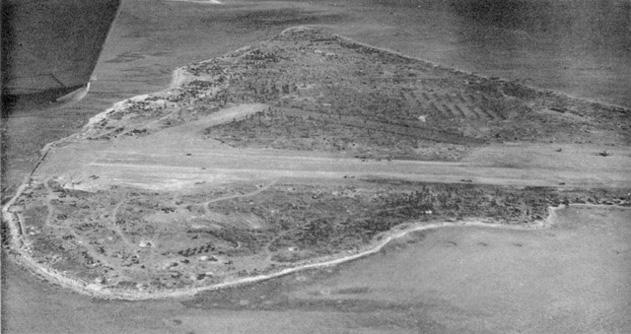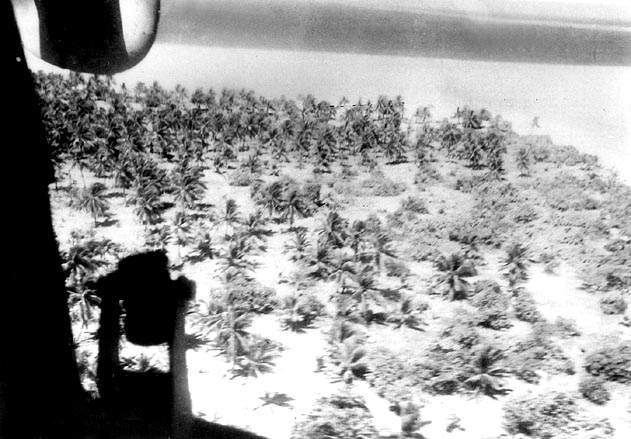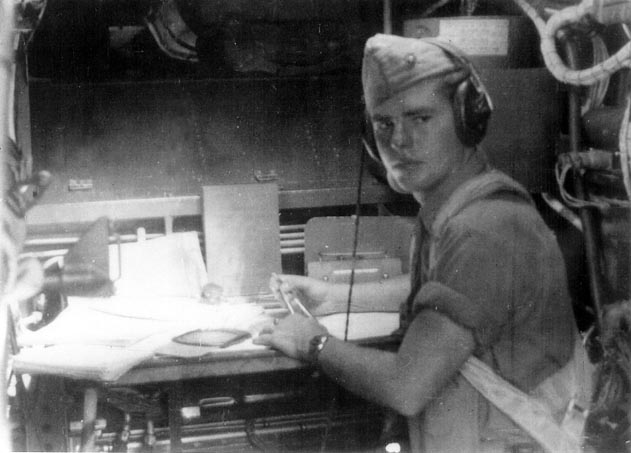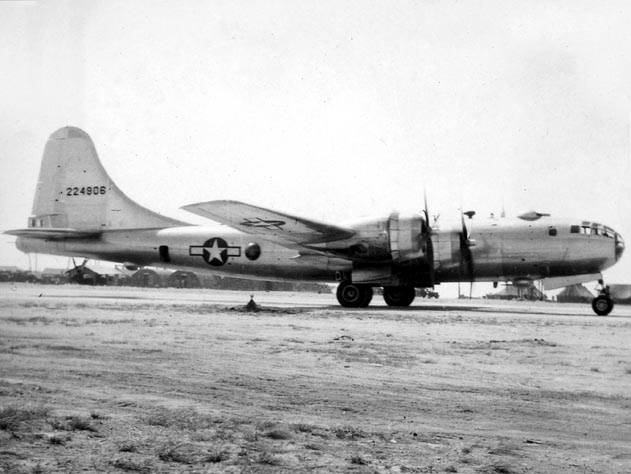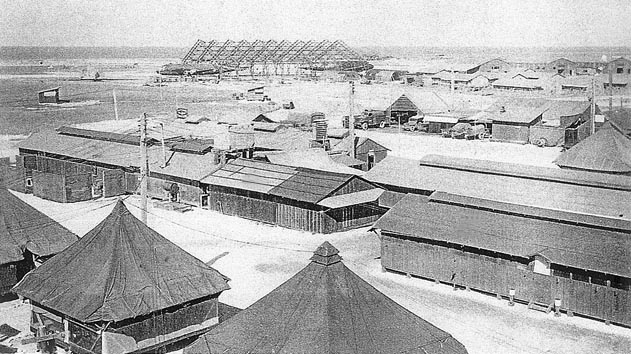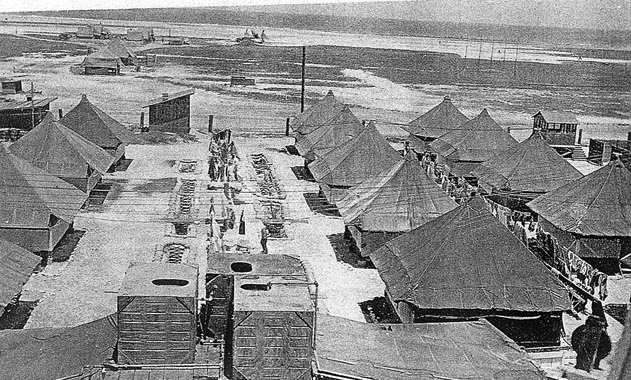|
|
||
|
|
||
|
|
APRIL 1945 A daily summary of squadron activities for the month is provided below. Additional details for significant events may be found at the linked text. April 1, 1945: VMB-613 is attached to Marine Air Group Ninety-Four (MAG-94). Four planes flew regularly scheduled sector searches. One plane conducted a snooper flight over Kusaie Island. One hunter-killer flight to Wotje (Aircraft Action Report 34). April 2, 1945: One plane flew a regularly assigned sector search. One plane conducted a snooper flight over Kusaie Island. Three hunter-killer flights and one additional anti-sub flight were flown, all negative. April 3, 1945: Patrols of shipping lanes commenced pursuant to Change 3 dated 1 April 1945, to Operations Plan No. 2-44 and Operations Order 7-44. Two planes flew regular shipping lane patrols between Kwajalein and Eniwetok. Five hunter killer flights were flown, all negative. One aircraft flew a special security patrol off Kwajalein Atoll. April 4, 1945: Two planes flew assigned shipping lane patrols. Two planes conducted searches of friendly atolls. One plane operated from Majuro in search of reported floating obstacle. One plane conducted a search flight over Kusaie. April 5, 1945: Two planes flew assigned shipping lane patrols. One plane searched remaining friendly atolls. Search out of Majuro for floating obstacle negative. April 6, 1945: Two planes flew assigned shipping lane patrols. Majuro obstacle search negative, secured. April 7, 1945: Two planes flew assigned shipping lane patrols. One plane conducted a search flight to Kusaie. April 8, 1945: Two planes flew assigned shipping lane patrols. April 9, 1945: Two planes flew flew assigned shipping lane patrols. One plane flew to investigate oil slick, negative. April 10, 1945: Two planes flew assigned shipping lane patrols. One search flight over southern friendly atolls, not complete coverage. April 11, 1945: Two planes flew assigned shipping lane patrols. Four hunter-killer flights. One plane searched Kusaie. One search flight over northwest friendly atolls, not completed. Two planes conducted a special search for reported task force, identified as friendly tugs and tows. One plane escorted VMF-111 on a strike to Ponape. April 12, 1945: Two planes flew assigned shipping lane patrols. One plane searched remaining friendly atolls to the south. One plane searched Kusaie. April 13, 1945: Two planes flew assigned shipping lane patrols. One plane searched northeast friendly atolls, and one plane completed coverage of the northwest friendly atolls. April 14, 1945: Two planes flew assigned shipping lane patrols. One plane took off for Kusaie but weather prevented the completion of the mission. One special flight for ground radar training purposes was conducted. April 15, 1945: Two planes flew assigned shipping lane patrols. April 16, 1945: Two planes flew assigned shipping lane patrols. April 17, 1945: Two planes flew assigned shipping lane patrols. One plane searched northwest friendly atolls. One ground radar training flight. April 18, 1945: Two planes flew assigned shipping lane patrols. April 19, 1945: Two planes flew assigned shipping lane patrols. Southern friendly atolls were covered by one plane. One search flight to Kusaie. One local photo flight. April 20, 1945: One plane flew assigned shipping lane patrol. One flight in aid of ground radar training. April 21, 1945: Two planes flew assigned shipping lane patrols. Three planes made search flights over northeast and northwest friendly atolls. April 22, 1945: Two planes flew assigned shipping lane patrols. One search flight over Kusaie was conducted. April 23, 1945: Two planes flew assigned shipping lane patrols. One search flight over Kusaie. One weather reconnaissance flight. April 24, 1945: Two planes flew assigned shipping lane patrols. One search flight over southern friendly atolls. One flight in support of ground radar training. April 25, 1945: Two planes flew assigned shipping lane patrols. Three planes in search flights over friendly atolls, coverage not complete. One plane flew a search flight to Kusaie. April 26, 1945: Two planes flew assigned shipping lane patrols. One plane completed coverage of northwest friendly atolls. One plane flew a photo flight to Mejit Island. April 27, 1945: Two planes flew assigned shipping lane patrols. One plane conducted a special administrative flight to Engebi, Eniwetok Atoll. April 28, 1945: Two planes flew assigned shipping lane patrols. One plane conducted a search flight to Kusaie. One anti-sub flight negative. April 29, 1945: Two planes flew assigned shipping lane patrols. April 30, 1945: Two planes flew assigned shipping lane patrols. One anti-sub flight. Four planes flew hunter-killer flights.
SHIPPING LANE PATROL: A convoy sails under the watchful eyes of three of VMB-613's crews. These patrols of the shipping lanes began on April 3, 1945 and continued through the end of the war. Photograph: U.S. Marine Corps, Clell Q. Thorpe Collection (Courtesy of the University of Houston Libraries)
CHANGING A NUMBER ONE STACK: Three of VMB-613's aircraft mechanics perform maintenance on the engine of one of the squadron's aircraft. Through the efforts of the maintenance section, VMB-613 had the lowest operational loss rate of all Marine Bombing Squadrons. Note that the aircraft's "package guns" have been removed. Photograph: U.S. Marine Corps (Courtesy of William A. Kehr)
TOUR ON TARAWA: Sergeant John J. Gavin (in cockpit) and his crew flew to Hawkins Field on Tarawa to conduct missions against the Japanese-held islands of Ocean and Nauru. Photograph: John Gavin (Courtesy of Bill Remick)
CLEANING THE CANNON: Aircraft armorer, Master Technical Sergeant Lloyd M. Staggs, "punches" the bore of the 75mm cannon on one of the squadron's aircraft. Photograph: U.S. Marine Corps, Arthur H. Navarre Collection (Courtesy of Diane Hindy)
PREPARING A DEPTH BOMB: Under the supervision of Technical Sergeant Oscar L. Robinson, VMB-613 armorers install hydrostatic and contact fuzes onto a depth bomb prior to loading it onto an aircraft. The engine of the aircraft can be seen in the background of the photograph. Photograph: U.S. Marine Corps, Arthur H. Navarre Collection (Courtesy of Diane Hindy)
VMB-613 FLIGHT LINE: In this photograph of VMB-613's flight line on Kwajalein six of the squadron's PBJ can be seen awaiting action. The aircraft in the foreground is MB-8. Photograph: U.S. Marine Corps (Courtesy of Roy Thorson)
ON PATROL: As one of VMB-613's aircraft patrols an assigned area, heavy cloud formations can be seen in the background. Such weather was typical in the Marshall and Eastern Caroline Islands. Photograph: U.S. Marine Corps (Courtesy of William A. Kehr)
ENGEBI AIRSTRIP: An aerial view of the fighter strip on Engebi Island, Eniwetok Atoll. Following the capture of the island, Seabees extended and improved the old Japanese airstrip. VMB-613 did not use Engebi as a forward operating base, although an number of administrative flights were made to the island. Photograph: U. S. Marine Corps
SEARCHING FOR JAPANESE: Seen from the radio-gunner's position, a surveillance flight over an island in Likiep Atoll reveals only palm trees and a peaceful lagoon. Note the empty mount for the .50 caliber machine gun in the left foreground of the photograph. In order to increase the aircraft's patrol range, these guns were removed, along with the Plexiglas window. Photograph: Marine Bombing Squadron Six-Thirteen (Courtesy of William A. Kehr)
NAVIGATOR AT WORK: Navigator, Technical Sergeant William A. Kehr keeps a close vigil on his aircraft's position in the navigator's compartment of his PBJ-1H. Due to the vast expanse of ocean with few landmarks, absolute navigational precision was essential to locate targets, and more importantly, to ensure a safe return to the airstrip on Kwajalein. Photograph: Marine Bombing Squadron Six-Thirteen (Courtesy of William A. Kehr)
B-29 SUPERFORTRESS: B-29 bombers headed to the bases in the Marianas routinely used the aviation facilities on Kwajalein Island to refuel before continuing on their long journey overseas. The same applied for B-29s returning to the United States. One squadron member compared the traffic on the airstrip at Kwajalein to Grand Central Station. Photograph: Marine Bombing Squadron Six-Thirteen (Courtesy of Robert Klinke)
4TH MARINE AIR WING AREA: Taken shortly after VMB-613's arrival on Kwajalein, this photograph shows the 4th Marine Air Wing's mess and office facilities. The long conjoined building in the center is the enlisted men's mess hall (far left), the galley (middle), and the officer's mess hall (right). The building at the center right. served as the offices for the Commanding General, the Intelligence, and Communications. Photograph: Marine Bombing Squadron Six-Thirteen (Courtesy of Clifford E. Willis)
TENT CITY: The forward echelon for Headquarters, 4th Marine Air Wing was located on Kwajalein. The tents served as billets for the Wing officers. This photograph was taken on December 27, 1944, shortly after VMB-613 arrived on Kwajalein. On that particular day, the temperature was reported to have been 127 degrees—in the shade! Photograph: Marine Bombing Squadron Six-Thirteen (Courtesy of Clifford E. Willis) |
|
|
Copyright © 2008 Marine Bombing Squadron Six-Thirteen Association. All Rights Reserved. |
||
